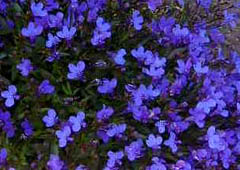 |
Photo Courtsey IFAS Palm Beach Extension
|
It turns out that we have a new disease, Impatiens Downy mildew, that specifically hits what most of us know as the “Common Garden Impatiens”, Impatiens walleriana. (Busy Lizzy) This disease does not infect other plants as of this time. There are other species of Downy mildew that infect most every plant if the pathogen is present and the conditions are right. However, it is very important to note that this disease does not infect New Guinea or Sunpatiens or any other flowers or herbs.
 |
| Downy Mildew on Impatiens |
Pennsylvania, like many states is a hotspot for this disease. If you had infected plants in your flower beds last year, then it is extremely likely that things will get worse this year. This pathogen overwinters quite well and can persist for many years.
How do you know if your Impatiens had it last year?
- Yellowish or pale-green foliage
- Downward curling of the leaves
- Distorted leaves
- White to light-gray fuzz on the undersides of the leaves. There are excellent images on the web if you search for “Impatiens Downy Mildew.”
- Emerging, new leaves that are smaller than normal and discolored.
- Flower buds that either fail to form or abort before opening.
- Stunted plants
Landscapers and those holding Pesticide Applicators Licenses have an additional option with an array of fungicides which if applied properly (timing and rate are very important) can control this disease. Home gardeners have a single active ingredient, phosphonic acid, marketed as Agri Fos, from Monterey Products and Exel LG from Organic Laboratories that should provide good control if used according to their labels.
The best option for many of us is to use alternative plants that perform well in the shade. Here are some to consider:
 |
Begonia 'Black Fancy' - UGA 2012 Trials
|
 |
| Picture Courtesy of Cornell University |
Wax begonias: These are a mainstay in the shade for many gardeners as they are compact, have good leaf color and texture and are available in market packs for larger plantings.
 |
| Lobelia erinus - Picture Courtesy of Cornell University |
 |
Impatiens hybrid 'SunPatiens Compact Electric Orange'
|
 |
Impatiens hawkerii 'Tamarinda Orange Orchid'
|
 |
| Torenia fournieri - University of Illinois (Wishbone Flower) |
 |
Solenostemon 'ColorBlaze Marooned' Coleus
|
 |
| Picture Courtesy of Cornell University |
 |
Alternanthera 'Purple Knight' (Joseph's Coat)
|
Our shady areas will probably look a bit different for the next several years, but there are some good options to Impatiens. Go to the SunPatiens’ website for advice on spacing, learn what this disease looks like and plan for another great gardening season.
Update: March 9, 2013. Master Gardener Tina Clinefelter (Clinton County) of Gardening in the Keystone State, adds her alternative selections to the list.
Update: March 20, 2013. Illinois Extension has more on the disease, with links to more alternatives from Michigan State University.
Update: March 23, 2013. The University of Maryland's Home and Garden Information Center describes the disease and offers alternatives here.
Update: April 9, 2013. Steve's counterpart for Buck's County, Educator Scott Guiser has a post on the subject which you can read here. He also links to the Michigan State Q&A and another alternatives list from Ball Seed Company.
Update: April 19, 2013. Washington Post horticulture writer Adrian Higgins covers the topic here.

This comment has been removed by a blog administrator.
ReplyDelete